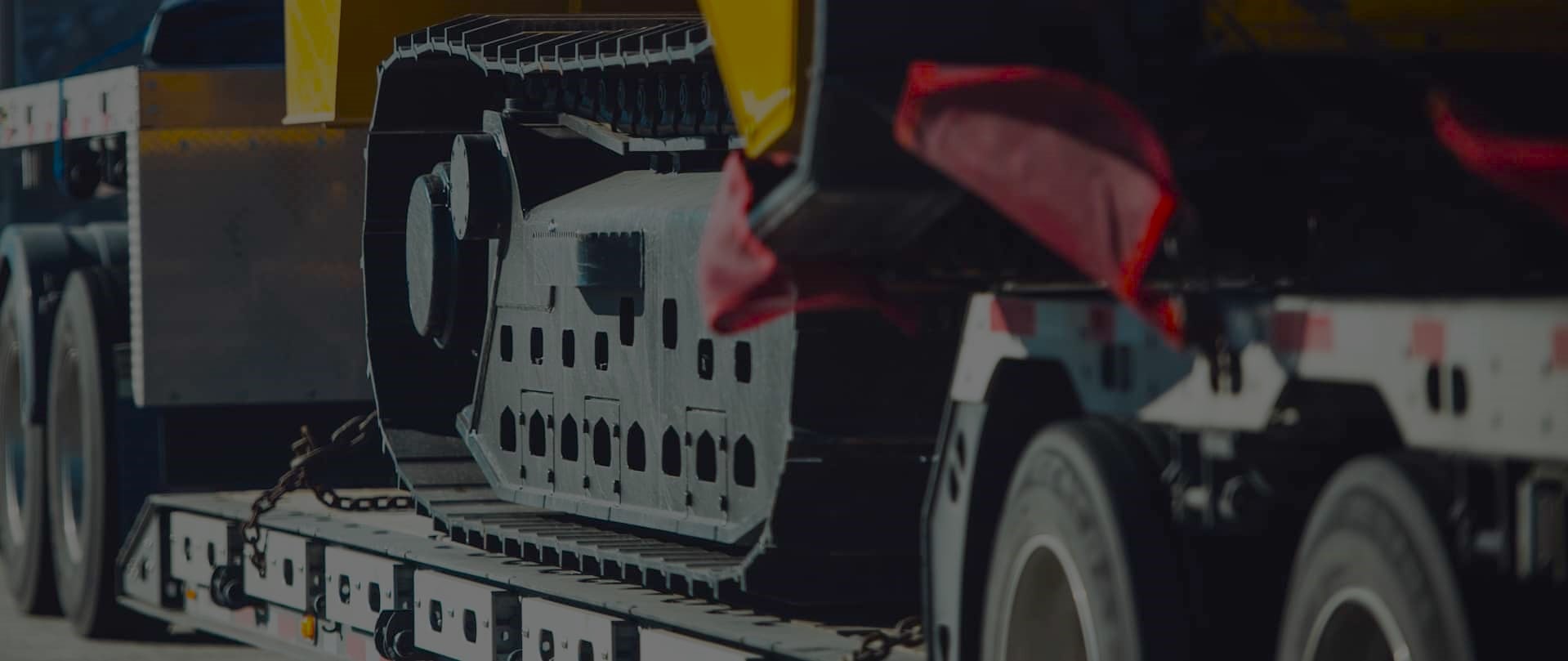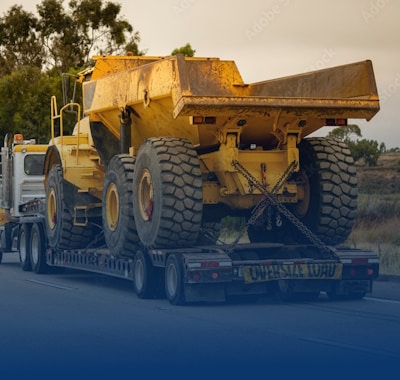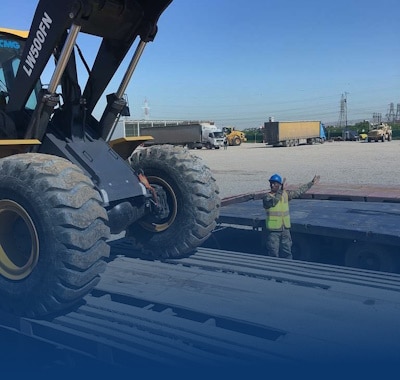Evaluating Transportation Companies for Heavy Equipment Moves
Freedom Heavy Haul can offer expedited Pickup and Delivery for any size shipment anywhere in the USA. Contact us today for No Hassle, No Pressure Pricing.
Moving heavy equipment like excavators or bulldozers is no small task. These items are not only large but also require careful handling to ensure safety and compliance with regulations. Whether it’s securing the load or navigating legal requirements, the process demands expertise.
Choosing the right company is crucial. A reliable provider understands the unique needs of transporting machinery. They ensure proper securement and adhere to FMCSA guidelines for oversized or overweight loads. This level of care minimizes risks and keeps operations running smoothly.
In a competitive market, service providers differentiate themselves through specialized knowledge and customer-focused solutions. This guide will help you identify the key factors to consider when selecting a partner for your needs.
Understanding Heavy Equipment Transportation Fundamentals
The logistics of moving large industrial assets are complex. These operations require meticulous planning, adherence to regulations, and a focus on safety. Whether it’s an excavator or a bulldozer, each piece of machinery demands specialized handling to ensure it reaches its destination securely.
Defining Heavy Equipment in the U.S. Context
In the United States, heavy equipment typically includes machinery weighing over 10,000 pounds. This classification covers items like cranes, loaders, and tractors. Weight thresholds are critical, as they determine the permits and securement methods required for transport.
Under 49 CFR 393.130, specific guidelines outline how these loads must be secured. These rules ensure that the cargo remains stable during transit, reducing the risk of accidents or damage.
Legal and Regulatory Requirements
Industry regulations play a vital role in protecting both the load and the public. The FMCSA sets strict standards for oversized and overweight shipments. These include obtaining the necessary permits, using escort vehicles, and following securement rules.
Safety protocols are equally important. Proper planning of the route, regular inspections, and adherence to procedural steps minimize risks. These measures ensure that the process is not only compliant but also efficient and reliable.
By understanding these fundamentals, businesses can navigate the complexities of moving industrial assets with confidence. We prioritize expertise and compliance to deliver seamless solutions for our clients.
Evaluating Transportation Companies for Heavy Equipment Moves
Ensuring a smooth relocation of construction machinery starts with the right team. The choice of a service provider can make or break the efficiency and safety of the move. We understand the complexities involved and prioritize expertise to deliver seamless solutions.
Key Factors to Consider
When selecting a partner, fleet quality is a top priority. Specialized trailers designed for industrial assets ensure secure and damage-free transport. A reliable provider will also offer timely service, minimizing delays and keeping your project on schedule.
Experience in the construction industry is another critical factor. Providers familiar with large-scale machinery understand the unique challenges involved. They can handle permits, route planning, and securement with precision, ensuring compliance and safety.
Role of Industry Expertise and Certification
Certifications are a testament to a company’s commitment to safety and professionalism. Look for providers with FMCSA compliance and other relevant credentials. These certifications guarantee adherence to industry standards and best practices.
Expertise goes beyond paperwork. A knowledgeable team can anticipate potential issues and provide solutions proactively. This level of insight ensures a smooth process from start to finish.
For more insights, check our guide on selecting a heavy equipment transport company.
Prioritizing Safety and Compliance
Safety is the cornerstone of every successful heavy haul operation. We prioritize adherence to regulations and securement rules to ensure the protection of both cargo and public safety. Our commitment to compliance guarantees a seamless and secure process for every move.
FMCSA Regulations and Securement Rules
The FMCSA sets strict guidelines to ensure the safe transport of industrial assets. Each vehicle must meet these standards, from securement methods to load stability. Properly restraining heavy machinery prevents movement during transit, reducing the risk of accidents or damage.
Under 49 CFR 393.130, specific rules outline how loads must be secured. These include using chains, binders, and other securement devices rated for the weight of the cargo. Compliance with these rules is non-negotiable for a safe move.
Permits, Escort Vehicles, and Safety Equipment
Permits are a critical need for oversized or overweight shipments. They ensure that the route is approved and that all legal requirements are met. Escort vehicles play a vital role in providing additional safety, especially for wide or tall loads.
Industry-leading providers also invest in advanced safety equipment. This includes reflective tape, warning lights, and specialized trailers designed for heavy machinery. These tools enhance visibility and stability, offering a robust solution for safe transportation.
When choosing a provider, look for:
- FMCSA compliance and certifications
- Experience in handling oversized loads
- Comprehensive safety equipment and protocols
By prioritizing safety and compliance, we ensure that every move is executed with precision and care. Trust us to deliver reliable solutions tailored to your needs.
Planning and Scheduling Your Heavy Equipment Move
Effective planning is the backbone of any successful heavy haul operation. It ensures that every factor is considered, from route selection to resource allocation. By addressing these elements, we minimize risks and maximize efficiency.
Route Planning and Timeline Management
The size and type of your cargo significantly influence the planning process. Oversized loads require detailed route analysis to avoid obstacles like low bridges or narrow roads. We prioritize safety and compliance by mapping out the most efficient path.
Timeline management is equally critical. Delays can disrupt project schedules and increase costs. We create realistic timelines that account for permit processing, weather conditions, and potential roadblocks. This approach ensures your cargo arrives on time, every time.
Logistics Coordination and Resource Allocation
Coordinating logistics is a complex task that demands expertise. We allocate resources strategically, ensuring that the right equipment and personnel are available when needed. This includes securing permits, arranging escort vehicles, and preparing for unexpected challenges.
Proper resource allocation also involves selecting the appropriate trailers and securement devices. These choices depend on the size and weight of the load. By aligning our tools with your needs, we guarantee a smooth and secure move.
| Step | Action | Benefit |
|---|---|---|
| 1 | Assess cargo size and type | Determines equipment and securement needs |
| 2 | Plan route and obtain permits | Ensures compliance and avoids delays |
| 3 | Allocate resources and personnel | Guarantees efficient execution |
| 4 | Monitor progress and adjust as needed | Maintains timeline and safety |
By following these steps, we ensure that every move is executed with precision and care. Our commitment to planning and scheduling guarantees a seamless experience for our clients.
Preparing Your Equipment for Shipment
Proper preparation is essential for a successful shipment of industrial machinery. Taking the time to inspect, clean, and secure your load ensures a smooth and efficient equipment transport process. These steps not only protect your assets but also help you avoid delays and compliance issues.
Pre-Move Inspections and Cleaning Procedures
Before any heavy equipment transport, conduct a thorough pre-move inspection. This step verifies the condition of your machinery and identifies any potential issues. Documenting the state of your equipment is crucial for insurance purposes and dispute resolution.
Cleaning your machinery is equally important. Removing dirt, debris, and grease allows for accurate condition documentation. It also ensures that your equipment is ready for securement and transport. A clean load is easier to inspect and handle, reducing the risk of damage.
Proper Load Securement Techniques
Securing your load correctly is a critical step in the equipment transport process. Follow FMCSA regulations and expert recommendations to ensure stability during transit. Use chains, binders, and other securement devices rated for the weight of your cargo.
Here are some practical tips for safe and effective securement:
- Inspect all securement devices for wear and tear before use.
- Distribute the weight evenly to prevent shifting during transport.
- Double-check all connections to ensure they are tight and secure.
Coordinating with your provider is also key. Discuss permit requirements and obtain a detailed quote for the transportation process. A reliable partner, like Freedom Heavy Haul, will guide you through these steps to ensure a seamless experience.
| Step | Action | Benefit |
|---|---|---|
| 1 | Conduct pre-move inspection | Identifies issues and documents condition |
| 2 | Clean machinery thoroughly | Ensures accurate documentation and securement |
| 3 | Secure load using FMCSA guidelines | Prevents shifting and ensures safety |
| 4 | Coordinate permits and quotes | Guarantees compliance and cost transparency |
Comparing Cost and Service Quotations
Understanding the financial aspects of moving industrial assets is crucial for making informed decisions. Pricing for these services involves multiple factors, including distance, weight, and insurance coverage. By comparing quotes, businesses can identify the most reliable and cost-effective solutions tailored to their needs.
Understanding Pricing Factors and Insurance Coverage
The cost of moving industrial machinery depends on several key elements. Distance and weight are primary factors, but additional permits and route complexities also play a role. Insurance coverage is another critical consideration, as it protects your assets during transit.
Here’s a breakdown of the main logistics components that influence pricing:
- Distance and route accessibility
- Weight and dimensions of the machinery
- Permit requirements for oversized loads
- Insurance coverage and liability terms
Requesting Comprehensive Quotes
To make an informed decision, request detailed quotes from multiple providers. A comprehensive quote should include all potential costs, such as permits, escort vehicles, and securement fees. This transparency ensures there are no hidden charges and helps you budget effectively.
When comparing quotes, evaluate the provider’s experience and track record. A seasoned company will offer insights into potential challenges and provide solutions proactively. This level of expertise ensures a smooth and efficient process.
For more guidance on selecting the right partner, check our resource on hiring a heavy hauling company.
| Factor | Description | Impact on Cost |
|---|---|---|
| Distance | Length of the route | Longer distances increase fuel and labor costs |
| Weight | Mass of the machinery | Heavier loads require specialized equipment |
| Permits | Legal requirements for oversized loads | Additional fees and processing time |
| Insurance | Coverage for potential damages | Higher premiums for high-value assets |
Leveraging Technology and Expert Insight
Technology plays a pivotal role in modern logistics, ensuring efficiency and safety. We integrate advanced tools to enhance every aspect of the moving process. This approach not only improves performance but also builds trust with our clients.
Digital Tracking and Load Monitoring Tools
Real-time tracking systems are now essential for seamless operations. These tools provide transparency, allowing customers to monitor their shipments at every stage. Load monitoring ensures that the cargo remains secure, reducing risks during transit.
Our fleet is equipped with cutting-edge technology to deliver reliable service. Here’s how these tools benefit your business:
- Enhanced visibility into shipment status.
- Improved communication between drivers and support teams.
- Proactive issue resolution using real-time data.
Consulting Industry Leaders for Best Practices
Expert insights are invaluable for optimizing logistics. We collaborate with industry leaders to adopt the latest best practices. This ensures that our processes align with the highest standards of safety and efficiency.
By leveraging expert knowledge, we can anticipate challenges and provide tailored solutions. This approach benefits your business by:
- Minimizing delays and disruptions.
- Ensuring compliance with industry regulations.
- Enhancing the overall customer experience.
Our commitment to technology and expertise guarantees a smooth and secure process. Trust us to deliver solutions that meet your unique needs.
Exploring Real-World Testimonials and Case Studies
Real-world experiences offer valuable insights into the reliability of service providers. Testimonials and case studies showcase how trusted companies deliver personal attention and dependable performance. These stories highlight the importance of teamwork, effective route planning, and comprehensive insurance coverage.
Insights from Industry Users
Industry users consistently emphasize the role of a skilled team in ensuring successful moves. One client shared, “The team at Freedom Heavy Haul handled our excavator transport with precision. Their attention to detail and communication made the process seamless.” Such feedback underscores the value of expertise and collaboration.
Effective route planning is another critical factor. A case study involving a bulldozer move across state lines demonstrated how meticulous planning avoided delays. The provider analyzed the route, obtained necessary permits, and ensured the asset arrived on time and undamaged.
Insurance coverage is equally vital. One testimonial highlighted how comprehensive insurance provided peace of mind during a high-value machinery move. “Knowing our asset was fully protected allowed us to focus on other aspects of the project,” the client noted.
Competitive price points also build trust. A construction company shared how they received a detailed quote that included all costs, from permits to securement. This transparency helped them make an informed decision and stay within budget.
| Case Study | Key Takeaway |
|---|---|
| Excavator Transport | Team expertise ensures seamless execution |
| Bulldozer Move | Route planning minimizes delays |
| High-Value Machinery | Insurance coverage provides peace of mind |
| Construction Equipment | Transparent pricing builds trust |
These real-world examples highlight best practices in moving industrial assets. By focusing on teamwork, planning, and protection, providers can deliver reliable and efficient solutions tailored to client needs.
Final Thoughts on Safe and Efficient Heavy Equipment Moves
Successfully relocating industrial machinery requires a blend of precision and expertise. Every move presents its own challenge, but thorough planning and compliance with regulations can overcome these obstacles. We prioritize safety and efficiency to ensure your machinery arrives securely.
Quality loading procedures are essential. Using the right loader technology minimizes risks and ensures stability during transit. Partnering with an expert provider guarantees that every step, from securement to route planning, is handled with care.
By embracing proven techniques and expert advice, you can achieve an efficient, obstacle-free move. Trust us to deliver solutions that meet your needs and exceed your expectations. Let’s work together to make your next relocation seamless and successful.







